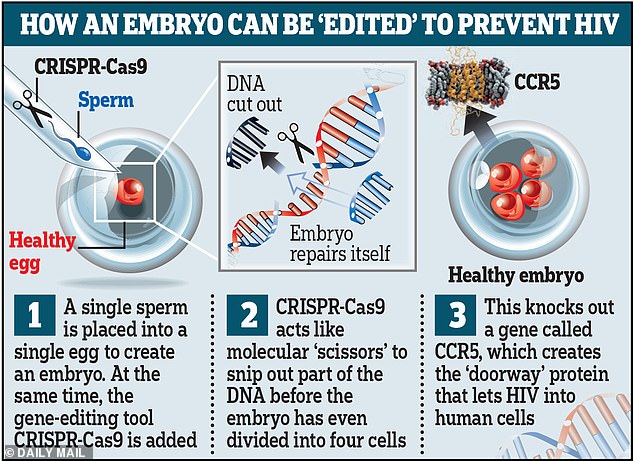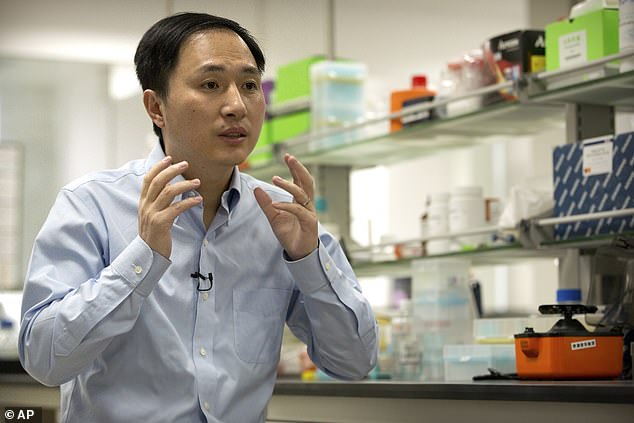Disgraced Chinese scientist He Jiankui, who was jailed in 2019 for genetically editing human babies, is back in the lab – and claims he is ‘proud’ of his past work
A disgraced Chinese scientist imprisoned for genetically editing human babies reveals he has returned to genetic research.
He Jiankui was sentenced to three years in prison in 2019 after announcing he had created the first genome-edited babies.
Now, just two years out of prison, Dr. He has revealed that he has opened three new laboratories to continue genetic experiments on human embryos.
Dr. He told the Japanese newspaper Mainichi Shimbun that he had no intention of creating any more genome-edited children.
Despite his arrest, he insists he is ‘proud’ of his past work, claiming: ‘Society will eventually accept it’.
He Jiankui (pictured at a 2023 press conference) announced that he has returned to the laboratory after being imprisoned for genetically editing human babies
Dr. He says he plans to develop gene editing techniques to treat rare diseases such as Duchenne muscular dystrophy and familial Alzheimer’s disease.
Despite his arrest and fierce criticism from the scientific community, he has opened three new research laboratories in Beijing and Wuhan.
This follows an earlier attempt to restart his research in Hong Kong, with Dr. He said he had obtained a visa under the island’s new talent scheme.
However, Hong Kong authorities revoked his visa less than a day after his announcement, claiming that Dr. He had ‘made false statements’ during his application.
Genetic editing of human embryos has been banned in China since 2003, but the procedure is permitted for purely non-reproductive purposes.
Dr. He insists that his work will be within the restrictions of Chinese law and that he will no longer make any attempt to produce living, genetically modified human children.
“We will use discarded human embryos and adhere to both domestic and international regulations,” he says.
In November 2018, Dr. He sent shockwaves through the scientific community when he announced that he had produced two genetically modified human babies.

In 2018, He Jiankui announced that he had used CRISPR-Cas9 to edit the genes of human babies in an attempt to make them HIV resistant
Dr. He told an international genetics conference in Hong Kong that he had modified the genes of twin girls, nicknamed ‘Lulu’ and ‘Nana’, to make them HIV-resistant.
Between 2016 and 2018, Dr. He edited the genes of embryos from eight couples in which only the father was HIV-positive.
Using a gene-editing technique called Crispr-Cas9, he rewrote parts of the embryos’ DNA with the aim of preventing the virus from being passed on.
He later revealed that a third genetically engineered girl was also born from these experiments.
After his announcement, Dr. He was immediately arrested and tried by Chinese authorities for ‘illegally carrying out gene editing of human embryos intended for reproduction’.
According to Dr. The twin girls are now five years old and are both going to kindergarten.
Dr. He, along with two of his colleagues who were also convicted, faced fierce ethical criticism of his experiments.

Dr. He (pictured in his lab in 2018) says he is proud of his research and that society will ‘eventually accept’ human genome editing
It was alleged that he unnecessarily continued with the risky and unnecessary treatment without adequate consent from the parents involved in pursuit of personal fame and profit.
During the trial it also came to light that Dr. He forged documents from an ethics review panel used to recruit couples for his experiments.
Although Dr. He admits that his research was ‘too hasty’, he has always maintained that his work benefited society.”
He says: ‘The results of analyzing (the children’s) complete gene sequences show that no changes to the genes occurred other than for the medical purpose, providing evidence that genome editing was safe.
“I’m proud that I was able to help families who wanted healthy children.”

